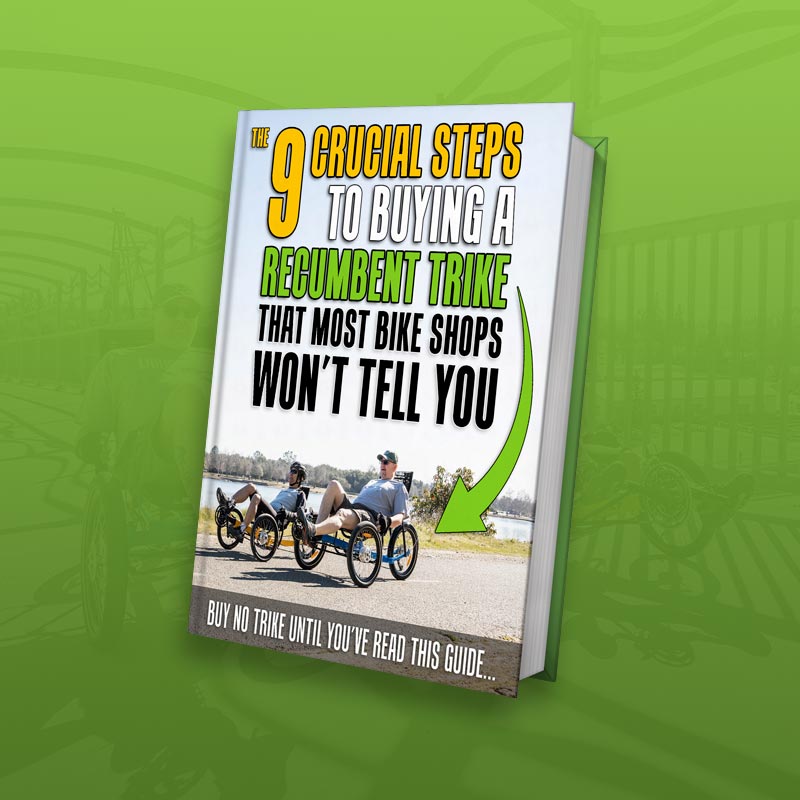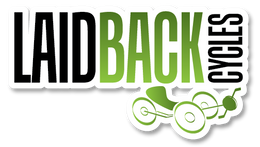I have not seen a more eagerly anticipated anticipated trike – posters on our forum greeted the announcement of its impending release with cheers, and each subsequent delay with jeers. Finally, it is released. Some early adopters have already received the trike, but many more are pestering dealers with questions about details, how it differs from existing TT models, and how long before there are more in stock for test rides and possible purchase. I was lucky enough to get my hands on one for a review. Well, make that two! And my conclusions? Was it worth the wait? Should you consider the Rambler? The answer is: Yes! And No! Turn the page for more.
The first thing you will notice when perusing the Terra Trike website is that there are several models of the Rambler. Four, to be exact. I was able to ride and compare the Internal 8 Speed and the Base 24 Speed. Both have features in common, as well as some significant differences – and the latter mostly involves, as you might expect, the gearing.
The Ramblers share the basics:
- Wheelbase Length: 38.5 inches
- Overall Length (medium): 67.5″
- Track Width: 30″
- Overall Width: 33″
- Bottom Bracket Height: 12.25″
- Seat Height: 15″
- Total Weight: 37 lb.
- Combined Load Limit: 300 lb.
- Turning Circle: 10′ diameter
The Internal 8 Speed has an 8 speed hub, with a gear-inch range of 24 – 80, while the Base 24 Speed, with its 8 cogs and 3 chainrings, boasts a range of 18 – 90. The former has the Zoom mechanical disc brakes, while the latter boasts Bengal mechanical discs. Can you tell the difference between these two brakes? I couldn’t! But the gearing is another story, which leads to my first recommendation.
If you ride in primarily flat areas, and seldom push the limits when it comes to top speed, then the 8 speed may be the Rambler for you. However, if you are surrounded by significant hills, like I am, then you should skip that model and take a closer look at the 24 speed. In car racing, it is often said there is no substitute for cubic inches. In riding bikes up hills, the same can be said for gears. The more, the better, and the lower the granny, the better you will like it.
There is one other factor to consider: weather and riding habits. If you regularly ride in conditions that most sane people would avoid, if you commute rain or shine, summer and winter, then the internally-geared hub deserves consideration. No more worries about gunk getting into your derailleurs – a better foul-weather commuter would be difficult to find.
OK, let’s take a ride on these trikes. As you might expect, they both handle the same. One thing that surprised me: I expected them to feel just like their sibling, the Rover. Close, yes, but the Rambler handles better, perhaps due to it’s lower weight, as well as some other relatively small differences, that seem to add up to a noticeable difference.
The turning circle is a very sharp 10 feet. It’s sharp enough, that if you are moving along quickly and abruptly turn sharply, you might just get the trike up on 2 wheels. This is to be expected, really, with such a turning circle, combined with a relatively high seating position. I would suggest that all riders familiarize themselves with just what combination of speed and turn will get that wheel up. Start slowly, then gradually increase the speed and the turn, to get used to just what combination will get you bicycling, and how to react when/if that happens.
One thing I have noticed about trike riders who buy models with variable recline angles of the seat (50 – 65 degrees here) is that many start out in the most upright position, and then later you’ll see that they have reclined to what is usually more comfortable, the most recline. As you might have noticed, even the most extreme is really not all that much. Many offerings from other companies exhibit a much more serious recline, often in the mid-20′s or even less.
So what does that mean to you? Not much, really. The seats are comfortable, the most laid-back position is beneficial, getting more weight onto your back and off your butt, but there is one other result: less aerodynamic benefit. At lower speeds, such as mid-teens and below, this is not a big deal. Higher than that, into the 20 mph range and above, then it does play a bigger part. The bottom line is that if you want to cruise with the big dogs at high speed, you are going to be working harder because of that rather tame recline.
There’s not much you can do to improve the aero of this trike (not helped by the wide positioning of the hands on the grips, either) – but there is something you can do to make any of the Ramblers go faster: change those tires! The standard tires are CST 20×1.75, 40 psi. Yes, 40 pounds per squre inch! At lower speeds, this is nothing to worry about. In fact, the lower pressures do make for a bit more comfy ride. But at higher speeds, you are going to be working harder, simply because there is more rolling resistance with those tires. Terra Trike offers an upgrade to Schwalbe Marathons. Their 100 psi results in a performance improvement that is noticeable, and well worth the $39.95 cost.
It’s bottom line time: in keeping with the title of this review, should you buy a Rambler? Perhaps. If you have some difficulty in dealing with getting on and off the relatively low seat height of many trikes, then yes, put the Rambler on your short list of trikes to try. If you’re a real hammer head, liking nothing better than showing roadies the back of your jersey, combination of relatively low top gears and modest seat recline angles, then perhaps the Rambler is not for you. But, if you’re quite happy with speeds a little less extreme, if you’re more of a tourist than a racer, then by all means consider the Rambler.
One other factor that may influence your interest: the price. Terra Trike historically offers good trikes at bargain price, and the Rambler is no exception. The 8 Speed Internal starts at $1399, while the Base 24 Speed is just $200 more, at $1599. My advice: unless the weather-protection of the internal hub makes a big difference to you, I would suggest the latter model is a better choice. Go for the upgraded tires, too. And while you have your wallet out, consider getting fenders, too: you’ll thank me when, not if, you get caught out on a rainy day.
Terra Trike Rambler
Pros: Price, turning circle, adjustability for riders of widely differing heights
Cons: Aerodynamics, standard tires


